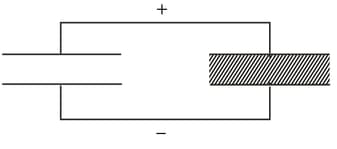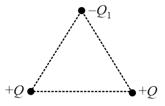Two parallel-plate capacitors, one filled with air and the other with a dielectric, have the same geometric dimensions, are connected in parallel, and are charged to a certain potential difference. In which of the two capacitors is the electric field strength greater, in which is the electric displacement greater, in which is the energy density greater, and in which is the surface charge density on the plates greater?


Important Questions on Electrostatics
Three point-like charges are positioned at the vertices of an equilateral triangles. Two are equal in magnitude and are like, while the third is opposite in sign. What should the magnitude of the third charge be so that the total interaction energy of the charges is zero?

The dielectric filling the space between the plates of a capacitor that has been charged and then disconnected from the voltage source is removed. How should the distance between the plates be changed so that the energy stored in the capacitor remains the same? Explain the origin of the change in energy.
A cube has been cut out from a piezoelectric crystal. When the cube was compressed, it exhibited electric charges on the faces: a positive charge on the upper face and a negative charge on the lower (Figure a). When the cube was stretched, the charges were found to change their signs (Figure b). What will be the signs of the charges on these faces if pressure is applied as shown in Figure c ?

